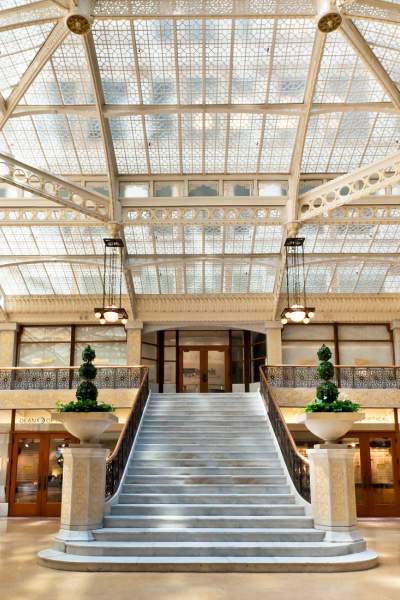One of America’s greatest architects, Frank Lloyd Wright called Illinois home—and filled it with some of his best works.
Today, Frank Lloyd Wright is known as one of America's greatest architects, but when he moved to Illinois at age 20, he was just a young draftsman looking for a job.
He found one. And then another. And then a better one. He married. He built a home and studio in Oak Park where he worked for 20 years. Throughout it all, he added more to Illinois' fabric and color than even he could have imagined.
Unlike the striking skyscrapers of Chicago’s skyline, which stand in stark contrast to the natural beaches and rural farmland that surround the city, Wright believed in designing structures that were in complete harmony with humanity and its surroundings. Known as the “Prairie” style, Wright’s ground-breaking ideas ignited a design revolution and made the Chicagoland area an epicenter of pioneering architecture that exists to this day.
During his lifetime, Wright designed more than 1,000 structures, 532 of which were completed. Oak Park itself is home to 25 buildings designed or redesigned by Wright, more than anywhere else in the world! It’s no wonder that architecture enthusiasts from across the country and around the globe come to Illinois to marvel at Wright’s work.

About the Frank Lloyd Wright Trail
A SELF-GUIDED ARCHITECTURAL ADVENTURE
Illinois' Frank Lloyd Wright Trail is a self-guided architectural adventure featuring 12 Wright-designed buildings, open to the public for tours. This includes two UNESCO World Heritage sites — the Frederick C. Robie House and Unity Temple.
On this page, you can find details on the trail and Frank Lloyd Wright's time in Illinois.
While many of his impressive works can be viewed from the exterior, be sure to check tour details and availability for each building prior to visiting.

Frank Lloyd Wright in Chicago
EARLY WORKS AND TRIUMPHS IN CHICAGO
Spend a day in Chicago exploring some of Frank Lloyd Wright’s most famous designs, from his early collaborations to a solo masterpiece.
Chicago is home to four famous Wright designs—Charnley-Persky House, Robie House, Emil Bach House and The Rookery.
Note: The Emil Bach House was unique as a Frank Lloyd Wright building that was previously available for renting overnight. Unfortunately the home closed at the end of 2023.
The Charnley-Perskey House
Wright helped design The Charnley-Perskey House, located at 1365 N. Astor Street in Chicago’s Gold Coast neighborhood, while a junior draftsman at the Adler & Sullivan architecture firm in 1892. The house is considered internationally as a pivotal work of modern architecture.
The Rookery
Located at 209 South Lasalle St., The Rookery served as Wright’s downtown Chicago office in 1898, and a satellite for his Oak Park studio. In 1905, Wright was commissioned to update the interior design and plan of the light court and lobbies. He realized a stunning balance between Burnham & Root’s ornamental ironwork and his own vision to create a spectacular environment. The Rookery remains one of his most dramatic interior compositions.
Frederick C. Robie House
Located at 5757 S. Woodlawn Ave. on Chicago’s South Side neighborhood of Hyde Park, the house is a UNESCO World Heritage Site and often considered the crown jewel of the Prairie style. In 1926, the house was sold to the Chicago Theological Seminary, which was interested in the site for purposes of future expansion. In 1941 a graduate student at the Illinois Institute of Technology accidentally discovered plans to demolish the Robie house and the subsequent outcry eventually lead to the Chicago City Council declaring the Robie House an official Chicago landmark.

Frank Lloyd Wright in Oak Park
THE LARGEST COLLECTION OF WRIGHT HOMES
His home and studio, an unusual complex located at 951 Chicago Avenue, served as Wright’s architectural laboratory where he tried out design concepts before sharing them with clients. Here, he raised six children with his first wife, Catherine Tobin, and designed such famous buildings as the previously discussed Robie House, Larkin Building and Unity Temple, also in Oak Park. With 25 Wright buildings in the neighborhood surrounding his home and studio, Oak Park is an outdoor museum of architectural history.
Unity Temple
Unity Temple is another UNESCO World Heritage Site. Late in his career, Wright declared it his "contribution to modern architecture." Indeed, it was a deeply personal project. When Oak Park’s Unitarian Church burned to the ground in 1905, Wright—a lifelong member—volunteered to design its replacement. Faced with a tight budget, Wright relied on clever design choices and plenty of concrete to build the cubist masterpiece, defying almost every convention of religious architecture along the way.
Frank Lloyd Wright Home and Studio
Of all the Oak Park homes designed by Wright, perhaps the most important is the one he made for himself. The Frank Lloyd Wright Home and Studio served as Wright’s private residence for the first 20 years of his career (1889–1909), during which he also tinkered with concepts in the sanctity of his studio before unveiling them to his clients (and the world). As such, the home itself offers insights into the subtle experiments and personal habits that informed the evolution of his work.

Frank Lloyd Wright in Springfield, Kankakee & Dwight
DOWN THE INTERSTATE SOUTH OF CHICAGO
Spread across 200 miles, three of Wright’s most impressive buildings evoke his signature prairie style. In fact, the B. Harley Bradley House was likely the very first home Wright designed in this style. The Dana-Thomas House reveals the extent of Wright’s creativity when money and space were no object and the Frank L. Smith Bank Building conveys Wright's belief that banks should express their own character rather than resemble temples of worship.
B. Harley Bradley House, Kankakee
Built 1900–1901, the B. Harley Bradley House is an essential stop on your survey of his career. The house sits on the banks of the Kankakee River, where you can embark on a half-hour cruise in an electric boat to see other homes along the shore—including another Wright-designed house right next door to the Bradley House.
Dana-Thomas House, Springfield
Commissioned in 1902 for a wealthy Springfield socialite, the Dana-Thomas House has a staggering floorplan with 35 rooms spanning 16 varying levels and 12,000 square feet of living quarters. The home also contains the world’s largest collection of site-specific art and furniture designed by Wright himself, including abstract light fixtures, oak tables, and terra cotta sculptures.
First National Bank Building, Dwight
Wright designed this bank building with a simple, dignified aesthetic. Remodelling through the years has restored much of that original dignity, and the building still operates as a bank more than 110 years after it was built—the only of Wright’s bank designs to do so.

Frank Lloyd Wright in Rockford, Hampshire, Belvedere & Geneva
WRIGHT'S LATER WORKS IN NORTHERN ILLINOIS
Take a break from the Prairie-style homes by visiting two properties that show how Wright’s philosophy changed toward the end of his career.
Less Prairie-style and more Little House on the Prairie, Muirhead Farmhouse is the only known farmhouse that Wright designed and built during his lifetime.
One of the hallmarks of Wright’s Usonian homes was a focus on practicality, and nothing embodies this more than the Laurent House—the only home Wright ever built specifically for a person with a disability.
Muirhead Farmhouse, Hampshire
Conceived in 1950, the house falls under the Usonians, a term coined by Wright to describe his pastoral vision of a more modest, middle-class style of American architecture. The Muirhead family still owns the residence, which sits on an 800-acre swath of farmland that includes four miles of public trails.
Laurent House, Rockford
Confined to a wheelchair following World War II, Kenneth Laurent wrote to Wright requesting a custom home that could accommodate his needs. In 1949, Wright unveiled his plan: a single-story fusion of form and function that incorporates an open floor plan, unrestricted access throughout the home, and materials sourced locally from Rockford.
Pettit Memoral Chapel, Belvidere
The Pettit Memorial Chapel is a small structure on the grounds of Belvidere Cemetery in Belvidere, Illinois. Emma Glasner Pettit, the sister of William A. Glasner, for whom Wright designed a home in Glencoe in 1905, commissioned the chapel in honor of her deceased husband, William H. Pettit. Wright used straight lines and very simple detail which was an extreme departure from the Victorian style that was popular at the turn of the century. It is the only cemetery memorial Wright ever designed.
Colonel George Fabyan Villa, Geneva
“The Villa,” as it was called, is a Prairie-style residence with an accompanying Japanese garden and Dutch windmill, both signs of the owners’ eclectic tastes. They hired Wright in 1907 to remodel the existing farmhouse, and today it is a museum which houses some of the owners’ private collections.

Frank Lloyd Wright's Legacy in Illinois
With such a significant portion of Wright’s famous career represented in Illinois, his buildings draw thousands to the state each year. Architecture students along with artists, intellectuals and creatives from all walks of life come to experience Wright’s evolution as a designer. His work fuels the imagination and inspires ingenuity, and is likely the reason Chicago is today considered one of the ultimate destinations for architectural studies.

Frank Lloyd Wright Road Trip
DISCOVER HIS WORK THROUGHOUT THE STATE
5 Days 400 Miles
Illinois is a larger than life gallery filled with many of Frank Lloyd Wright’s architectural masterpieces.
Take this road trip to tick off all his most significant works and enjoy other incredible architecture, great food and accommodation suggestions for your trip.

